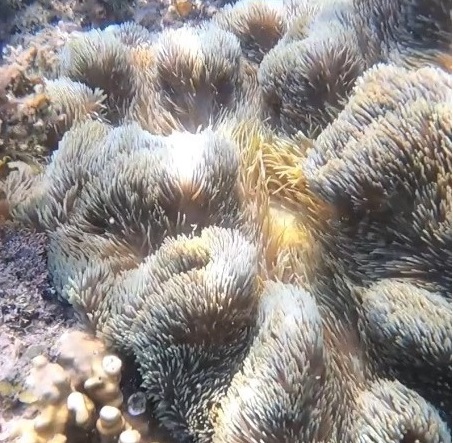In the kaleidoscopic world beneath the ocean’s surface, where vibrant coral reefs and exotic marine life abound, one creature stands out for its mesmerizing beauty and enigmatic allure—the carpet anemone. Found in the shallow waters of tropical oceans, these remarkable creatures are not only a sight to behold but also play a vital role in maintaining the delicate balance of their marine ecosystems.

Carpet anemones, scientifically known as Stichodactyla species, are a type of sea anemone characterized by their large, flat bodies and colorful tentacles. Unlike their cousins, the more commonly known clownfish-hosting anemones, carpet anemones typically do not form symbiotic relationships with fish. Instead, they rely on their stunning appearance and potent sting to capture prey and defend themselves against predators.
One of the most striking features of carpet anemones is their vibrant coloration. Ranging from deep shades of red and purple to bright hues of green and blue, these creatures are a kaleidoscope of colors that add a splash of brilliance to the ocean floor. The vivid tentacles, which can number in the hundreds, create a stunning contrast against the backdrop of the sandy seabed, making carpet anemones a favorite subject for underwater photographers and marine enthusiasts alike.

Despite their delicate appearance, carpet anemones are formidable predators. Armed with specialized cells called nematocysts, located on their tentacles, they are capable of delivering a potent sting to immobilize their prey. Small fish, crustaceans, and even unsuspecting swimmers can fall victim to the carpet anemone’s deadly embrace, making it a force to be reckoned with in the underwater world.
In addition to their hunting prowess, carpet anemones also play a crucial ecological role in their marine habitats. As filter feeders, they help to maintain water quality by removing excess nutrients and organic matter from the surrounding environment. Furthermore, their presence provides shelter and protection for a variety of marine organisms, including shrimp, crabs, and juvenile fish, who seek refuge among their tentacles.
Despite their ecological importance, carpet anemones face numerous threats in the wild, including habitat destruction, pollution, and overexploitation for the aquarium trade. Climate change, with its rising sea temperatures and ocean acidification, also poses a significant risk to these delicate creatures, disrupting the delicate balance of their ecosystems and threatening their survival.
Conservation efforts aimed at protecting carpet anemones and their habitats are therefore essential to ensure their long-term survival. This includes establishing marine protected areas, implementing sustainable fishing practices, and raising awareness about the importance of preserving these unique creatures and the ecosystems they inhabit.
In conclusion, carpet anemones are a testament to the breathtaking beauty and complexity of the underwater world. With their vibrant colors, formidable hunting abilities, and ecological significance, they are a fascinating species that deserves our admiration and protection. By working together to safeguard their habitats and promote responsible stewardship of our oceans, we can ensure that future generations will continue to marvel at the enigmatic beauty of carpet anemones for years to come.

